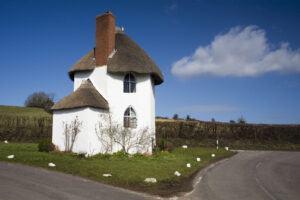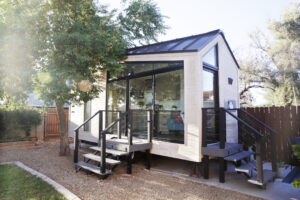
Adoptable appendices in the International Residential Code for cob construction and tiny houses
![]() In addition to the International Codes (I-Codes) being a comprehensive and coordinated family of codes, what they also provide is a level of flexibility for authorities having jurisdiction (AHJ). Specifically, 13 of the 15 2021 I-Codes include adoptable appendices, all of which have undergone the rigors of the full code development process and approval by the membership. In other words, these appendices undergo the same process that is used to develop and update the body of the code itself. The ICC Performance Code and the International Zoning Code do not currently contain adoptable appendices.
In addition to the International Codes (I-Codes) being a comprehensive and coordinated family of codes, what they also provide is a level of flexibility for authorities having jurisdiction (AHJ). Specifically, 13 of the 15 2021 I-Codes include adoptable appendices, all of which have undergone the rigors of the full code development process and approval by the membership. In other words, these appendices undergo the same process that is used to develop and update the body of the code itself. The ICC Performance Code and the International Zoning Code do not currently contain adoptable appendices.
Adoptable appendices are provided in the code to support consistency in policies across jurisdictions that adopt them. They may also address less common or emerging topics that would benefit from incorporation in the model codes. Adoptable appendices include the following phrase in their introduction describing how AHJs can effectively use them: “The provisions contained in this appendix are not mandatory unless specifically referenced in t![]() he adopting ordinance.” This phrase was inadvertently left out of the title of a new Appendix AU on Cob Construction (Monolithic Adobe) in the first printing of the 2021 International Residential Code (IRC). This has been corrected in the posted errata and the correct text will be in the second printing of the IRC.
he adopting ordinance.” This phrase was inadvertently left out of the title of a new Appendix AU on Cob Construction (Monolithic Adobe) in the first printing of the 2021 International Residential Code (IRC). This has been corrected in the posted errata and the correct text will be in the second printing of the IRC.
This piece focuses on two contemporary adoptable appendices in the 2021 IRC, namely, Appendix AU Cob Construction (Monolithic Adobe) and Appendix AQ Tiny Houses.
IRC Appendix AU Cob Construction (Monolithic Adobe)
New in the 2021 IRC is an adoptable appendix for cob construction. The provisions for cob construction are based on code change RB299–19 from the 2019 Group B cycle of code development. The following are excerpts from the reason statement and the code itself, which provide an overview of the new appendix provisions:
 Cob is an earthen material mix of clay-soil, straw and water that is placed into a wall in layers to create a monolithic wall. The material is similar to adobe bricks. It is a non-combustible material.
Cob is an earthen material mix of clay-soil, straw and water that is placed into a wall in layers to create a monolithic wall. The material is similar to adobe bricks. It is a non-combustible material.- This material has been used for thousands of years, notably in England and Northern Europe.
- Cob buildings typically feature raised impermeable foundations and extended roof eaves to protect the walls from moisture and weather.
- Cob can greatly reduce embodied energy and life cycle carbon dioxide emissions in buildings. It is highly recyclable.
- Cob walls are limited to one story, not more than 20 feet in height and located in Seismic Design Categories A, B and C unless an approved engineered design is provided.
- Cob walls can be used in areas with ultimate design wind speeds up to 140 mph.
Similar to the format for the body of the code, this appendix is structured as follows:
- AU101: General (Scope, Intent and General provisions)
- AU102: Definitions
- AU103–AU109 Technical provisions
-
- AU103: Material, Mixing and Installation
- AU104: Finishes
- AU105: Cob Walls — General
- AU106: Cob Walls — Structural
- AU107: Cob Floors
- AU108: Fire Resistance
- AU109: Thermal Performance
- AU110: Referenced Standards
IRC Appendix AQ Tiny Houses
The 2018 IRC included an adoptable appendix for tiny houses. The provisions for tiny houses were based on code change RB168–16 from the 2016 Group B cycle of code development. They have been subsequently revised in the 2021 IRC by code change RB292–19 in the 2019 Group B cycle of code development.
The following are excerpts from the reason statement and the code itself, which provide an overview of the appendix provisions:
 The average size of a new single-family home grew from 1,780 square feet in 1978 to 2,479 square feet in 2007 and then to 2,662 square feet in 2013.
The average size of a new single-family home grew from 1,780 square feet in 1978 to 2,479 square feet in 2007 and then to 2,662 square feet in 2013.- Small homes are typically 400 to 1,000 square feet with “tiny homes” most often being less than 400 square feet with some as small as 80 square feet.
- The small house movement attracted interest after Hurricane Katrina in 2005 and then the financial crisis of 2007–2008.
- The increase in popularity led to concerns regarding safety among tiny house professionals.
- One of the challenges the industry faced included zoning regulations that required minimum square footage for new construction and how to address those houses on wheels versus those on a foundation.
- Another challenge was compliance with the prescriptive requirements in the body of the IRC. In response, the proponents of tiny houses noted that while compliance with the IRC could possibly be achieved, the size of the structure makes certain requirements less critical from a safety standpoint. Specifically, the smaller size of these houses provides the occupants with familiar surroundings giving credence to reducing the need for certain requirements.
- Tiny house requirements include: limiting the size of the house to 400 square feet; access to lofts by a ladder to save space without requiring a guard (similar to a bunk bed); a limited occupant load; allowances for built-in furniture; and a relaxation in area and width of floor areas and hallways and minimum ceiling heights.
- The current 2021 IRC has been expanded to include new requirements for energy conservation.
Similar to the format for the body of the code, this appendix is structured as follows:
- AQ101: General (Scope)
- AQ102: Definitions
- AQ103–AQ106 Technical provisions
-
- AQ103: Ceiling Height
- AQ104: Lofts
- AQ105: Emergency Escape and Rescue Openings
- AQ106: Energy Conservation
- There are no standards referenced in the provisions
Tiny houses are typically constructed in a factory setting — often called “off-site” or “modular” construction — and transported to the site and placed on a permanent foundation. While the code provisions of Appendix AQ, if adopted, govern code compliance, since the unit is built off-site, challenges can arise in terms of assessing the manufacture of the unit and how to inspect for code compliance. The International Code Council recently completed two ICC standards for off-site construction to address these challenges and offer a path for compliance, namely: ICC/MBI Standard 1200–2021 for Off-Site Construction: Planning, Design, Fabrication and Assembly; and ICC/MBI Standard 1205–2021 for Off-Site Construction: Inspection and Regulatory Compliance.
These are just a couple of examples of how the adoptable appendices in the I-Codes can be utilized by AHJs to add additional regulations to their adopting ordinance to address unique needs within their jurisdiction.








